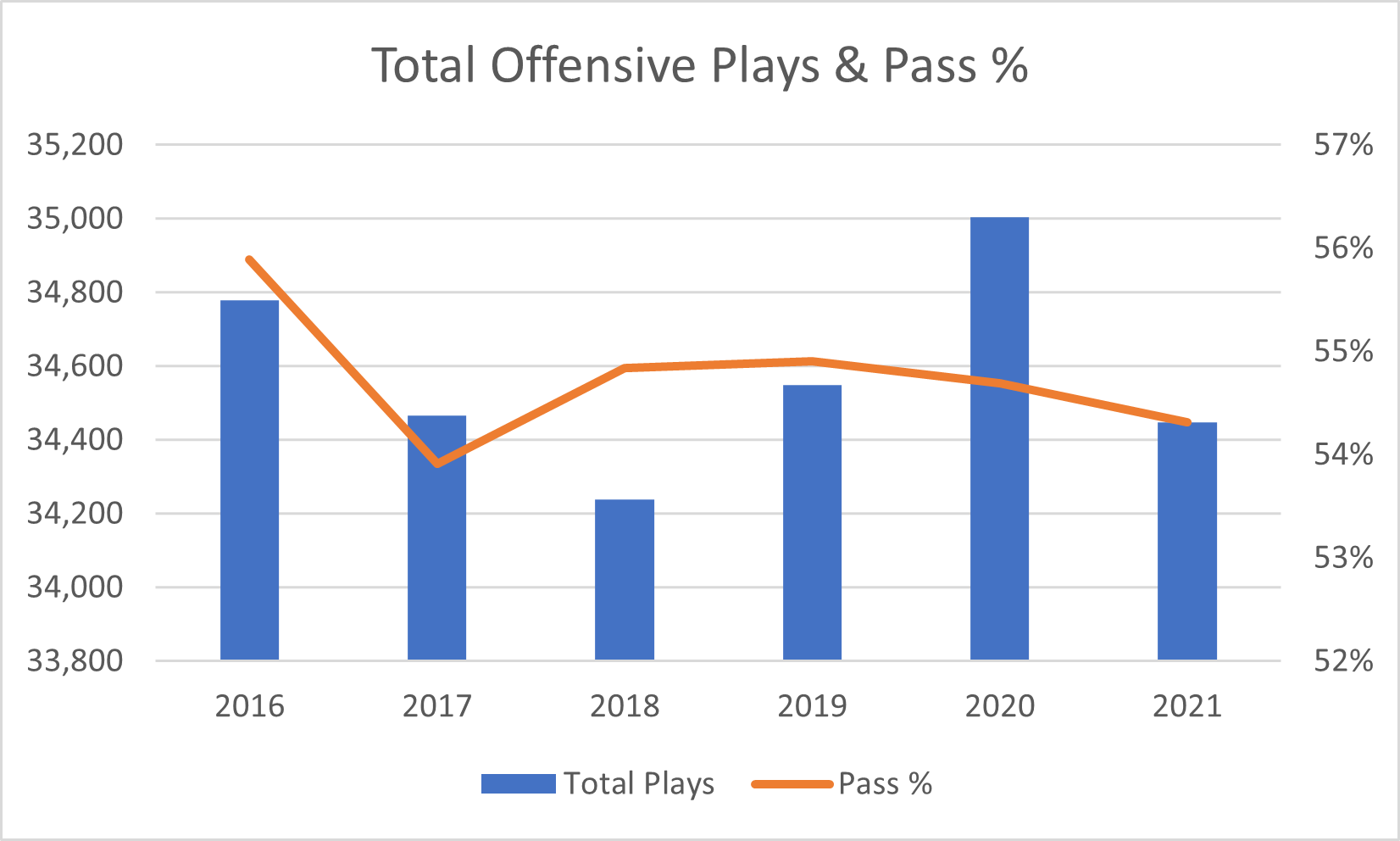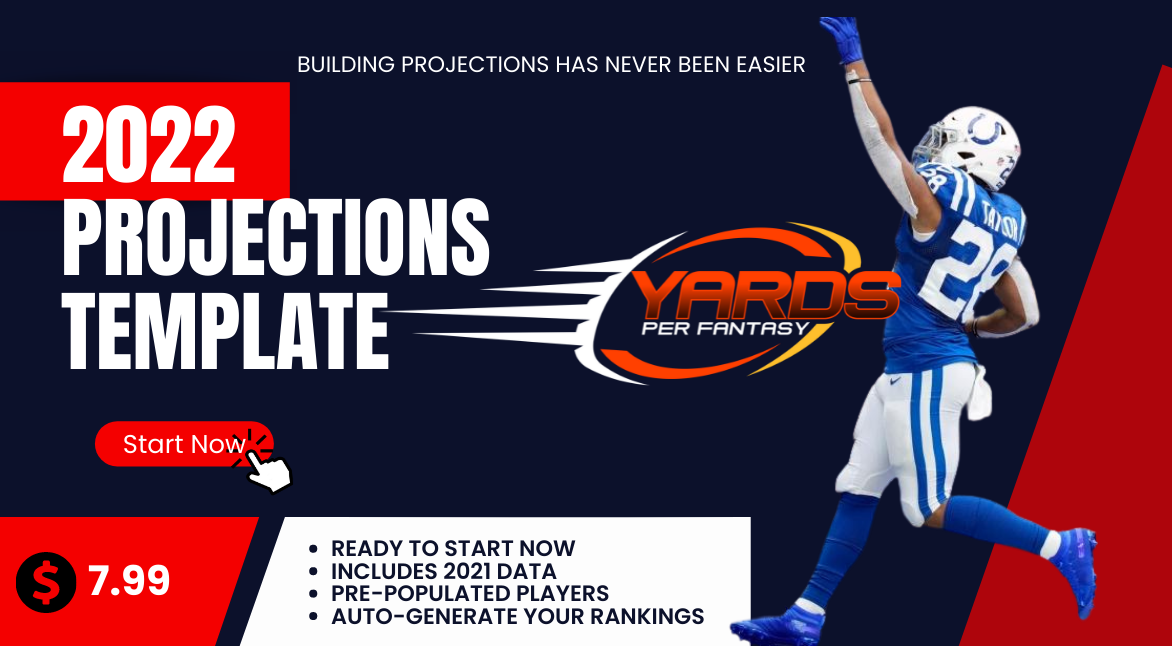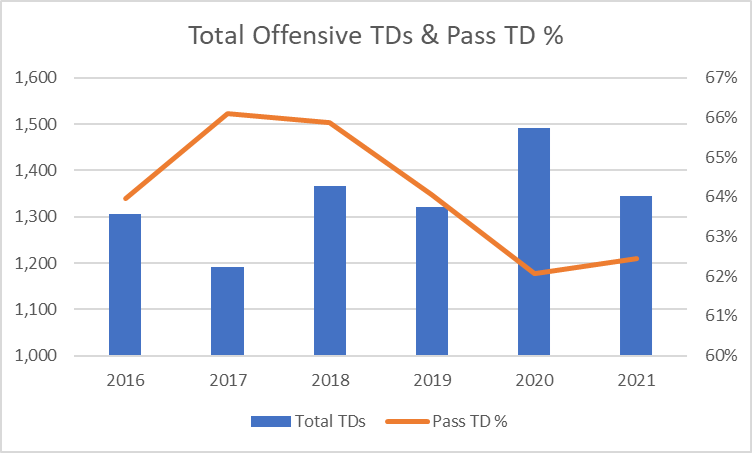
A Guide To Building Projections In 2022
He finished as RB4 on the season but only RB7 on a points-per-game basis; that other guy is coming back from injury so will eat in to the workload; this new coach has a tendency to throw the ball more; they drafted a top lineman so will be able to run the ball better…. does this all sound familiar and leave you with a conundrum on what to expect from players next year? That’s where projections come in.
The projections process can be a bit daunting but if you break it down in to some key parts and start with last year’s data as a baseline, then you’re already half way there.
A lot’s going to change between now and the start of the 2022 season (trades, injuries, etc) but it’s a great time to get the process set up and review the 2021 numbers. That’s why we’re here.
PROJECTIONS TEMPLATE – $7.99 – GET NOW!
Play Volume
What are we looking at?
Start at the top. How many plays is the team going to run? Teams have certain tendencies and offer a level of predictability in how many plays they’ll run. For example, Green Bay have established a reputation for using every second of the play clock on every play, which leads to less plays. They finished bottom half in total offensive plays run.
Why does it matter?
In 2021, the Baltimore Ravens ran 1,185 offensive plays while the Seattle Seahawks ran 954. That’s 231 more plays over the course of a season, or nearly 25-percent.
If we conservatively assume 5 yards per play then that could be 1,155 yards of offense, or 115 fantasy points rushing/receiving, not to mention catches in PPR formats. You better believe that’s going to make a difference to where players are going to rank.
What happened in 2021?

Note: 2016-2020 numbers have been normalised to a 17 game season for comparison with 2021
2020 saw a big jump in play volume across the league and in last year’s version of this same article my note was to expect regression back down towards previous levels. As you can see from the chart above, that’s exactly what happened. 2020 was the outlier, 2021 was back to normal.
What about 2022?
As noted above, the 2021 levels are in the ‘normal’ range (i.e. they clearly aren’t an outlier like 2020 was) so it’s reasonable to project something similar for 2022. Statistical outliers are, by nature, not very predictable so it would be bold (and unnecessary) to try and project something outside of the statistical norms.
Pass Ratio
What are we looking at?
Once we have the overall play volume, the next step is understanding how much of that volume goes through the air and how much is on the ground. These ratios may change in different circumstances and some teams have a clear strategy depending on the gamescript, while others will stick to the same plan regardless. The Titans, for example, are one of the most run-heavy teams in the league no matter what the gamescript is, whereas the Buccaneers keep slinging that ball at the highest rate in the league even if they’re ahead.
Why does it matter?
AJ Brown received a 20-percent target share for Tennessee in 2020, while Chris Godwin received less than 18-percent of Tampa Bay’s targets – so you want the AJ Brown target volume right? Wrong.
20-percent of Tennessee’s pass attempts gave Brown 105 targets. Godwin’s ‘less than 18-percent’ of Tampa Bay’s targets was 127 targets, an extra 22 targets.
It’s important then to know what the team is doing with the ball to flush out how much opportunity there is through the air and on the ground.
What happened in 2021?
If you look again at the overall play volume chart above, you may notice that the passing ratio has been fairly stable across the league over the past few years, somewhere between 53 and 56-percent overall.
However, the individual teams ranged from 46-percent to 64-percent, that’s a big range. In 2020, that range was wider (41-percent to 63-percent) and in 2019 it was similar again. Over the 3 years, 4-5 teams finished above 60-percent and 4-5 finished below 50-percent each season.
What about 2022?
Across the league we can probably expect some similar numbers but it’s the individual team tendencies that will need to be reviewed. Watch out for the changes in head coach and offensive coordinator to understand how their approach may change, and look at what major player movements tell us about team intent – the Baltimore Ravens for example traded away Marquise Brown during the draft and drafted two tight ends in the process, this could signal an intent to run the ball as much as possible.
And don’t forget to think about league-wide tendencies. There was a lot said in 2021 about the two-high defense limiting those big explosive plays so it wouldn’t be surprising to see offenses swing more towards short and intermediate passing coupled with power running games.
Touchdowns
What are we looking at?
Total touchdowns is the first part of this but then the split of passing touchdowns and rushing touchdowns is the next level to look at. The better the offense, the more touchdowns they are likely to score, it’s pretty logical. And understanding the split of passing and rushing touchdowns is exactly the same process as the play volume, if we project more rushing touchdowns then the running backs will get a bump.
Why does it matter?
Are you sitting down? Are you ready for this? Touchdowns = points. The Seahawks and Patriots scored the same number of touchdowns in the regular season, but Seattle scored 6 more through the air than New England did. Which Quarterback do you want in that scenario?
What happened in 2021
Note: 2016-2020 numbers have been normalised to a 17 game season for comparison with 2021
Look at those total touchdowns across the league in 2020. I noted in last year’s review that 2020’s touchdown total went through the roof and to expect regression back down, and that’s exactly what happened.
As for the split, the ratio of passing touchdowns bounced back a touch with both passing and rushing touchdowns coming back somewhere close to ‘normal’.
What about 2022?
The regression balanced back out in 2021 so I’d be projecting something similar for 2022 without expecting major movements.
Weekly Projections
When it comes to weekly touchdown projections during the season, I’m very much led by the Vegas implied totals which is calculated from the over/under and the spread. If you’re building a projections model I recommend building this calculation in to your sheet so you can see the implied team totals.
Here’s the calc: (Over/Under divided by 2) minus (spread divided by 2)
Example: If the game has an over/under of 50 and the spread is -4 (in favour of team A) then team A’s implied total is 25-(-2) = 27. Team B’s spread is +4 so their implied total is 25-(+2) = 23 (as a check, the team totals add up to the over/under of 50, and they are 4 points apart which matches the spread). If you get stuck with the +/- then remember that the team with a minus spread is the favourite and should end up with more points than the underdog!
You should then be looking to project your touchdowns within that implied total, remembering to consider the split between passing and rushing touchdowns. If the New York Jets have an implied total of 14 points then there’d be no point in projecting 5 touchdowns.
Now, two things that I consider here:
- Teams score field goals, extra points, and defensive points so a 27 point total isn’t likely to come entirely from passing and rushing touchdowns. On average, 65-percent of points scored across the league were from offensive touchdowns in 2021. Each team is different and it’s different week to week so it’s probably not accurate to apply wholesale, but you should consider it.
- This is a probability game. If you have the ability to foresee exactly who’s going to score the touchdowns for each team then I’ll meet you in Vegas. Otherwise, you need to have a method to put some projections against anyone who could score a TD without putting all your eggs in one basket and leaving others empty. My personal process is to apply a decimal probability to all of the players. For example, if I need to split 3 touchdowns across the Bengals then I might give Chase 0.7, Higgins 0.6, Mixon 1.0, Tyler Boyd 0.4 and the Tight Ends 0.3.
Market Share
What are we looking at?
Here’s where we convert the team projections in to the individual player projections. The target volume and rushing volume need to be attributed to the skill position players for each team. This is where we give 25-percent of the targets to Wide Receiver A and 60-percent of rushing attempts to Running Back B, for example.
How do we go about it?
Start with last year’s numbers, but don’t just take the final totals as that won’t tell you the full picture.
Derrick Henry only had 40-percent of the Titan’s rush attempts in 2021 but he only played 8 games so it’s a fair assumption that a fully-fit Henry would eclipse that share.
The context is important, and reviewing the team data across the season can provide much more insight in starting your process for next season.
Key Suggestions / Notes
- Set up your projections system so that you can apply a percentage to each player rather than manually trying to calculate it. It might take you some time to set up initially but will save a lot of time through the season
- Don’t forget the little guys. I know it’s tempting to assign all of Buffalo’s targets to Diggs, Knox, Davis, Crowder, Singletary and McKenzie but 12 different players got at least one target in 2021 and 10-percent of targets fell to Zack Moss, Tommy Sweeney, Matt Breida, Jake Kumerow and Reggie Gilliam. There are a number of ways you can address this depending on the level you want to go to, but don’t forget these peripheral players
- Throwaways. The league average in 2021 was 3-percent of a team’s pass attempts that were thrown away, that’s 3-percent of targets that aren’t going to anyone. It differs across the quarterbacks though: Kyler Murray has been up over 4-percent for the last three seasons while Matthew Stafford was at a 1.3-percent rate in 2020 and a crazy 0.5-percent rate in 2021. Don’t forget to include these or you’ll over-project the receivers and the quarterback’s completion rate.
- Make sure you look at rushing volume for the quarterbacks and other position players as well. If a team has 300 rush attempts, they won’t all be divvied amongst the running backs, there’ll be quarterback scrambles and designed runs, wide receiver jet sweeps, etc
Metrics
What are we looking at?
We now know how many targets or carries a player is going to get and how many touchdowns, but we need to know how many yards they’re going to get on those touches.
How do we go about it?
There are a few advanced stats for fantasy football we need as a minimum:
- Catch percentage for targets
- Yards per Target or Yards per Reception – either will work as long as you calculate it correctly
- Yards per Carry (calm down, I know there’s a ‘YPC is a bad stat’ movement but we’re not using it to make judgements on who is a good running back, we need it to generate the numbers!)
If you really want to go to town, you can go as deep as you want. You can look at aDOT (average depth of target), YAC (yards after catch), YBC (yards before catch), air yards, WOPR (weighted opportunity rating), and any other stat you can find data on. But be prepared that the more detail you go to, the longer it takes to put together your projections.
Key Suggestion
Spend the time setting up your projections template for the data that you can get access to and that you are comfortable understanding and projecting. Don’t go overboard on your first go.
Quarterbacks
This is the last position to look at and that’s because those other stats will drive 90-percent of the Quarterback’s numbers. If you have projected 500 team pass attempts, then the Quarterback has 500 attempts. When you’ve projected the wide receivers, each will have ended with a number of receptions and receiving yards – add them up and you get the pass attempts and passing yards for the quarterback. So let the rest of the team’s projections give you the Quarterback projection.
What you do need to do is apply yards per carry to their rush attempts and project their interceptions.
A step I find useful at this point is to look at the calculated Quarterback numbers (the passing yards, completion percentage, etc) and compare them to previous data for those players. Putting in the receiver stats might make sense on their own but if it spits out a Quarterback completion percentage of 80-percent and 7,000 passing yards then something isn’t right and you’ll need to pull back those individual projections.
Wrap it all up
I’m not going to go through all the specifics on how to bring it all together but if you’re not sure stick to the basics:
- Targets x Catch-percentage x Yards per reception (or Targets x Yards per target) = receiving yards
- Rush attempts x Yards per carry = rushing yards
- Apply formulas to the yards, catches (for PPR formats) and touchdowns to give you fantasy points
- Have a summary sheet that pulls through all the players and their projected totals
If this is your first time doing projections, congratulations and good luck. You might be surprised in the outcomes.
Range of Outcomes
Fundamental principle time. The results you get from your projections are based on your best estimate of the most likely outcome.
Remember, if you think you can correctly predict exactly how everything will play out in the NFL season then you need to let me know what time to meet you in Vegas. The reality is that there a lot of variables that are very hard to predict and subject to a lot of external factors. The result being that there are a range of outcomes for every player. Some players will have a fairly small range of outcomes (you know the ones, safe floor of guaranteed targets but they never blow the doors off) and others will have a huge range of outcomes from complete bust to league-winner (I’m not saying Trey Lance here but I’m not not saying it either…).
The point is, once you’ve completed your projections you need to give it a dose of reality check and think about the factors that could push those results in either direction. That will help you get a confidence level on your projections and on individual players.
And here’s a tip: when you’re looking at a player in later rounds and thinking about what would need to happen for them to hit the high-end of their outcomes, the less factors you can think of the better. Give me the player who only needs 1 thing to happen to hit his ceiling over the player that needs 5.
Data
As for gathering the data, there are different sources available for different data with many sites providing parts of what you need and others having it spread out across their site. I’ve personally found that it’s time-consuming to jump around the different pages to understand the full picture, or a lot of work to pull together everything you need in one place.
That’s why Yards Per Fantasy put together a database of team data for 2021 that includes weekly stats for each player across all the key categories including target share, yards, aDOT, air yards, YAC, WOPR, and red zone usage for all players who received a target or a carry during the regular season, with the entire team’s data all on one page.
We’ve been doing the hard work so you don’t have to. The summary data is available on the Yards Per Fantasy team profiles and we’ll make the whole database available during the offseason.
And you can use the Yards Per Fantasy Projections Template to get started. We’ve been updating the document to make it as useable as possible and to put all the data you need right there at your fingertips. You’d be surprised how long it takes just to set up a document with all the teams and the formulas, not only does our template save you that time but it simplifies the whole process. When you’re done, you can automatically see your sorted rankings and can even spit out your top 12s in a ready-made graphic to post all over your social media.
Hit me up with any questions on Twitter.
Ready to Give It a Try?
PROJECTIONS TEMPLATE – $7.99 – GET NOW!
YOU’RE GETTING:
- Includes Team-by-team 2021 data built in and league averages for comparison
- Players are pre-populated for you, saving hours of set up time!
- Ready to start making projections right now!
- Auto-generated rankings for each position in whatever setting you choose
- Customizable scoring including Tight End Premium
- Create your own tiers within your rankings and use them while you draft
- Export rankings to show them off on social media
- Turn it into Weekly Projections during the season
- Video Tutorial









